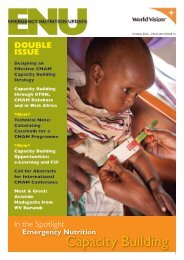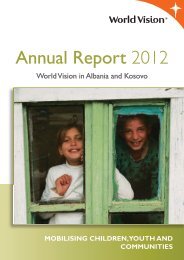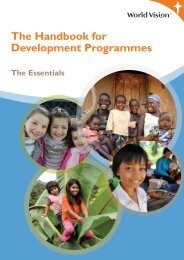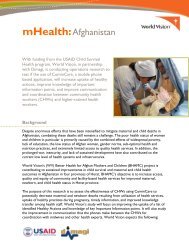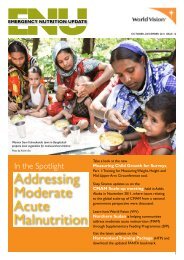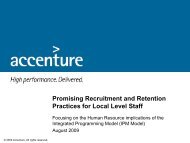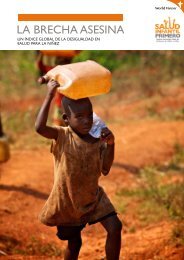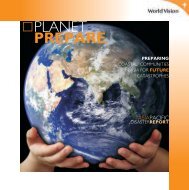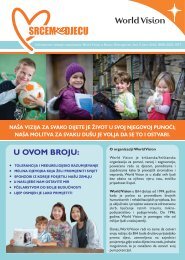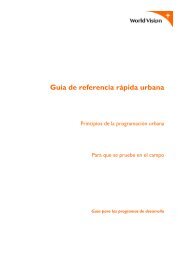the right to inclusive education for children with disabilities
the right to inclusive education for children with disabilities
the right to inclusive education for children with disabilities
You also want an ePaper? Increase the reach of your titles
YUMPU automatically turns print PDFs into web optimized ePapers that Google loves.
achieved, as well as <strong>the</strong> difficulties that <strong>the</strong>y had encountered and areas where intervention was needed.So this process was repeated day after day, helping thus <strong>the</strong> moni<strong>to</strong>ring of <strong>the</strong> progress of <strong>children</strong> and <strong>the</strong>streng<strong>the</strong>ning of cooperation between <strong>the</strong>m. Initially in this school <strong>the</strong>re were not enrolled <strong>children</strong> <strong>with</strong>severe or obvious diagnosis.Their <strong>education</strong> still remained a challenge in Albania at that time. Certainly <strong>the</strong> increasing number ofstudents who attended a special school, raised <strong>the</strong> need of increasing <strong>the</strong> number of teachers who wouldwork in this school. Perhaps <strong>the</strong>se reasons, but also increased demands of <strong>the</strong> number of <strong>children</strong> <strong>with</strong><strong>disabilities</strong>, made special classes move <strong>to</strong> a separate building. In 1974, ano<strong>the</strong>r special class was opened and<strong>the</strong>se two classes opened <strong>the</strong> way <strong>for</strong> <strong>the</strong> establishment of a genuine special school <strong>for</strong> this category of<strong>children</strong>.At a later stage, <strong>the</strong> doors of <strong>the</strong> special school were opened also <strong>for</strong> <strong>children</strong> <strong>with</strong> severe diagnoses, suchas <strong>children</strong> <strong>with</strong> <strong>the</strong> down syndrome, <strong>with</strong> mental retardation of varying degrees. Their enrollment wasmade possible after <strong>the</strong>ir situation was first assessed by an admission committee, set up in school. Thiscommittee was composed in addition <strong>to</strong> <strong>the</strong> schools’ managing team, also of a methodologist teacher(teacher’s name Hava Haxhiu) who assessed <strong>children</strong> <strong>for</strong> <strong>the</strong>ir academic achievements, and two heal<strong>the</strong>mployees (psychiatrist Dr. Anastas Suli and child psychiatrist doc<strong>to</strong>r Dr. Elida Cangonji) who assessed <strong>the</strong>physical and mental status of <strong>children</strong>.Teachers in this school were distinguished <strong>for</strong> great dedication and professional commitment <strong>to</strong> support<strong>the</strong> process of educating <strong>children</strong> <strong>with</strong> <strong>disabilities</strong>. A great amount of work in <strong>the</strong>se schools was made interms of adjustment and adaptation of textbooks <strong>to</strong> <strong>the</strong> level of skills and capacities of <strong>children</strong>. Shortagesin materials and teaching <strong>to</strong>ols, were covered by <strong>the</strong> creativity and professionalism of <strong>the</strong> teachers inbuilding <strong>the</strong>mselves <strong>the</strong>ir necessary material base.It was not long till <strong>the</strong> school was turned in<strong>to</strong> a resource center and exemplary school <strong>for</strong> o<strong>the</strong>r specialschools in <strong>the</strong> country. Teachers in this school held open class sessions, or as were called differently at <strong>the</strong>time “open learning”, which were attended not only by teachers and school managers of special school,but also of <strong>the</strong> 8 - year ones of <strong>the</strong> basic <strong>education</strong>.In this school began <strong>to</strong> enroll also <strong>children</strong> who came from <strong>the</strong> orphanage, as well as those who comefrom families <strong>with</strong> social and economic issues (divorced parents, convicted, deported, those who manifestenvironmental and circumstantial deficiencies etc.). Teachers show that <strong>the</strong>y had a close cooperation andrelationship between parents and <strong>the</strong>ir <strong>children</strong>, which reflected significantly in <strong>the</strong> positive results achievedin working <strong>with</strong> <strong>the</strong>se <strong>children</strong>.Until <strong>the</strong> 1990s <strong>the</strong> school experience was very positive in terms of preparing students <strong>for</strong> skills andprofessional skills. Under an agreement signed between <strong>the</strong> leaders of this school and work office in <strong>the</strong>Executive Committee of <strong>the</strong> Tirana District, students in <strong>the</strong> seventh and eighth grades, conducted <strong>the</strong>irteaching practice in <strong>to</strong>wn’s enterprises such as <strong>the</strong> “NPV”, <strong>the</strong> artistic enterprise, tailoring enterprises,porcelain enterprise, wool industry, knitwear, <strong>to</strong>urism and hotel company. Children were allocated in <strong>the</strong>seinstitutions according <strong>to</strong> <strong>the</strong>ir abilities and capabilities after being moni<strong>to</strong>red <strong>for</strong> a long time by <strong>the</strong>ir teachers.Teachers of wood craft of <strong>the</strong> school (<strong>the</strong>re were about 4 - 5 such teachers) supervised <strong>the</strong> developmen<strong>to</strong>f teaching practice in <strong>the</strong>se enterprises. At <strong>the</strong> end of <strong>the</strong> school, coinciding <strong>with</strong> <strong>the</strong> end of eighth grade,<strong>the</strong>se students were employed on <strong>the</strong> basis of professional skills acquired during <strong>the</strong> teaching practice in<strong>the</strong>ir respective enterprises. Be<strong>for</strong>e <strong>the</strong>se students were hired as employees of enterprises, <strong>the</strong> schoolteachers would prepare <strong>the</strong> environment and o<strong>the</strong>r employees <strong>to</strong> welcome and <strong>to</strong> value <strong>the</strong>m as equal<strong>to</strong> students <strong>with</strong> <strong>disabilities</strong>. They held in<strong>for</strong>mational meetings about <strong>the</strong> characteristics of development,behavior, skills and capacities of <strong>the</strong>se students, <strong>with</strong> employees of <strong>the</strong>se enterprises. In collaboration <strong>with</strong><strong>the</strong> direc<strong>to</strong>rs of <strong>the</strong>se companies, employees were assigned <strong>to</strong> supervise and take care of <strong>the</strong>se students.Young people <strong>with</strong> <strong>disabilities</strong> who began working at <strong>the</strong>se companies, were rewarded <strong>for</strong> <strong>the</strong> work <strong>the</strong>yper<strong>for</strong>med just as well as all o<strong>the</strong>r employees of <strong>the</strong> enterprise through <strong>the</strong> payroll system. They were paidabout 4,000 Lekë per month. Many of <strong>the</strong>m already contributed <strong>to</strong> <strong>the</strong> provision of household income,shattering this way <strong>the</strong> myth of <strong>the</strong>m being a burden <strong>to</strong> family and society. Although students had leftschool and worked in various enterprises, interest and care of school teachers in companies where <strong>the</strong>yworked, was part of ongoing care <strong>to</strong>wards <strong>the</strong>m.22 The <strong>right</strong> <strong>to</strong> Inclusive Education <strong>for</strong> <strong>children</strong> <strong>with</strong> Disabilities



